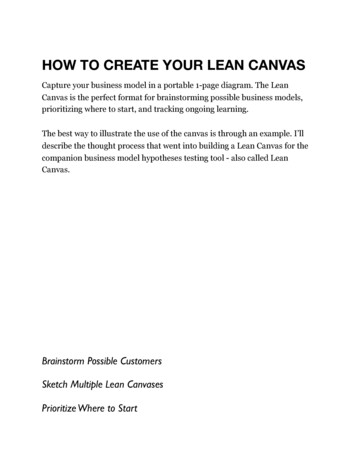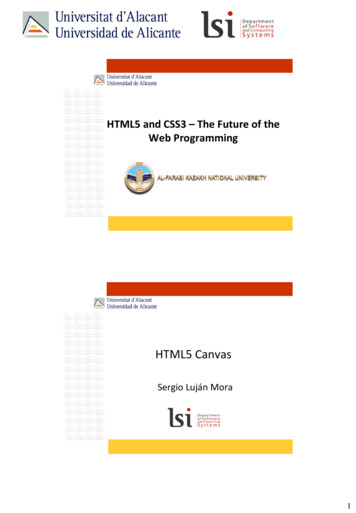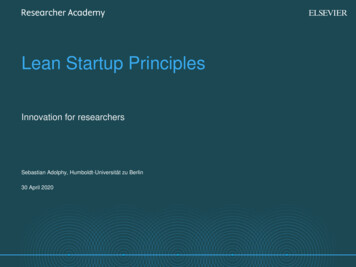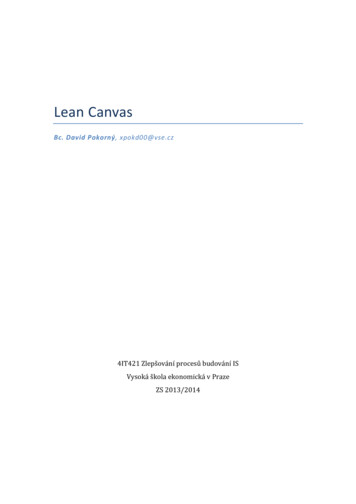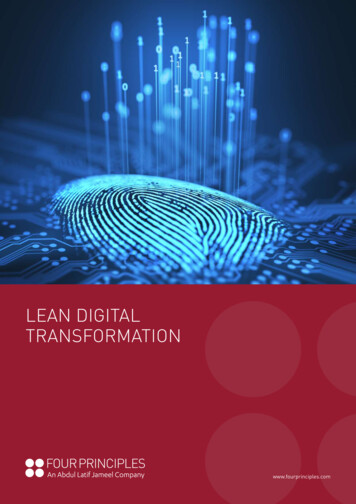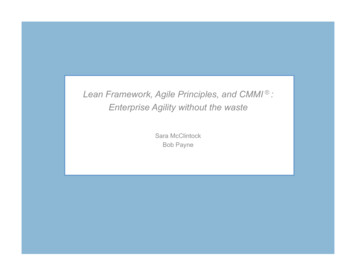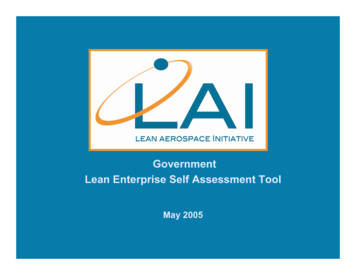
Transcription
DE GRUYTEROPENApplied Computer Systemsdoi: 10.1515/acss-2016-00042016/19Introduction to Lean Canvas Transformation Modelsand Metrics in Software TestingPadmaraj Nidagundi1, Leonids Novickis21IITMinds, India, 2 Riga Technical University, LatviaAbstract – Software plays a key role nowadays in all fields,from simple up to cutting-edge technologies and most oftechnology devices now work on software. Software developmentverification and validation have become very important toproduce the high quality software according to businessstakeholder requirements. Different software developmentmethodologies have given a new dimension for software testing.In traditional waterfall software development software testinghas approached the end point and begins with resource planning,a test plan is designed and test criteria are defined for acceptancetesting. In this process most of test plan is well documented and itleads towards the time-consuming processes. For the modernsoftware development methodology such as agile where long testprocesses and documentations are not followed strictly due tosmall iteration of software development and testing, lean canvastransformation models can be a solution. This paper provides anew dimension to find out the possibilities of adopting the leantransformation models and metrics in the software test plan tosimplify the test process for further use of these test metrics oncanvas.Keywords – Lean canvas, software testing, software validation,software verification, test process.I. INTRODUCTIONNow the growing technology makes human depend in dayto-day life more on software embedded devices. Softwareitself plays a key role in human life. The softwaredevelopment has also changed from the past decade and newdevelopment methodologies are introduced by new fastsoftware development and testing concepts such as agile. Onthe one hand, fast development of software is going on and, onthe other hand, fast validating and verification parallelsupporting built high quality error free software in a fast wayaccording to the requirements.In a software development company the software testingprocess gives more power to build high quality software. Inrecent years software testing has gained more valueproposition that can directly impact the software building anddelivering process. The lean canvas transformation modelsmay bring a new dimension to software testing overcomingmany obstacles such as test plan, long test documentation, testresource planning to software release.The word “lean” comes from lean manufacturing and showsthe elimination of unnecessary waste “muda” from the processand brings the value proposition of the overall process. Thelean concept is re-used by Ash Maurya for the lean canvas forthe business [1]. Till nowadays lean canvas was used as abusiness mode and for defining a business plan, a problem,solutions, key metrics and possible advantages.The lean process concept is focused on the removing of thewaste and improving the efficiency of the developmentprocess. This can have a direct impact on speeding up thesoftware development process and reducing the developmenttime as well as the cost. Meanwhile a company can develophigh quality software in the correctly estimated timeframe.Many studies have shown that lean main advantage isdelivering the product earlier than the planned time. It meansthat the software developer team develops and delivers moreproduct functionalities in short time and the testing team canverify and validate them. This can also influence the projectfinance and directly customers. The adoption of the leanprocess concept in software development improves thedecision making in the team and keeps the team motivated allthe time. This way it can affect the quality of the final productof the customer.A. Scientific Novelty of PaperLean canvas is created to evaluate the business model. It isone white board with several segmentations that mean alightweight one-page document that shows the productcreation to evaluate marketing fit.Our core contribution is to highlight the identified testmetrics and possibilities of adoption of the use of lean canvastransformation models in the software test process.Specifically: To identify the entry criteria, exit criteria for the softwareproduct testing.o In waterfall model where software testing process atthe end and long test documentation are timeconsuming.o In agile where software development cycle is veryshort and software testing needs to be done in time andthere is very less time for lightweight testdocumentation creation.o In software test documentation, where it is verydifficult to cover all test items.o In test planning where before software testing starts atest plan must be ready. To evaluate possibilities of adoption lean canvastransformation models in software testing. To find the way to generate different test metrics, whichaffect the software testing. 2016 Padmaraj Nidagundi, Leonids Novickis. This is an open access article licensed under the Creative Commons Attribution ), in the manner agreed with De Gruyter Open.UnauthenticatedDownload Date 7/8/16 10:17 AM30
Applied Computer Systems2016/19B. Structure of PaperThe current paper is divided into the three main sections andconclusion. Section 1 formulates the problem and Section 2provides the brief introduction of related studies to businessmodel canvas by using modern approach. Section 3 showstesting process and indication of lean test metrics for furtherutilisation for the canvas board. II. THE PROBLEM WE TACKLEWe have many challenges which concern the software testplanning to manually test as well as automatically tilldelivering tested software to end customer. In the manualtesting process, a developer develops software and assumes itstester job to test it, and the company does not have any testprocess. A tester’s responsibility is to pick up and test theitem; thus, a tester is a middleman between a developer and anend customer, a key person who is directly responsible tobring the high quality software [3]. The most commonchallenges a tester can face: Complete testing of the software application:Is it possible? To test all possible amalgamationincluding manual testing as well as the automation one,there may be a combination of thousands of tests needed.With a large number of tests a tester is never able todeliver the tested software product to an end customer. Fig. 1. Block diagram for the test process overview. Misinterpretation of the test process at a company:Sometimes at a company a tester is not very muchfocused on the well-defined test process and sometimes atester follows the whole well-defined process but still itdoes not apply to its current testing scenario. This all leads to the imperfect and unsuitable software producttesting.Person-to-person communication with developers:Sometimes a big problem in a software developmentcompany is communication between the developer andthe tester or the test team. The tester needs to know howto manage the relationship and keep goodcommunication skills.Verifying the software in regression testing:When the software project has grown and become morecomplex, the time of regression testing becomesunrestrained. Regression testing thrusts to manage thefunctionality changes comparing the new with theprevious developed software and reports defects.Absence of the proficient tester:It is a pure management decision to add the proficienttester or not well trained tester in the project and expecthigh results. This leads towards the poor tested softwareproduct to end software users.Testing time restriction:Most of time, we have noticed the boss comes and sayswe are releasing the software soon. Now the tester is in ahurry to complete the whole list of tasks within the timerestriction. On this way the tester can focus only on thecompletion of the work and not on the test coverage.Executing the earliest test cases:This is pretty challenging to take the right decision forwhich test cases are very important and need to beexecuted with of priority. This is under pressure all thetime.Comprehension of the requirements:In some situations the tester is directly responsible forthe communication with the end customer to analyse andcomprehend the requirements. In most situations thetester needs to focus very much on the listing andunderstanding the requirements to test the software in theright way.Exit criteria for software testing:To make a right decision to stop testing is an arduousresolution, the pre-defined exit criteria can help simplifythis process. It is a very important step where all testprocesses get stopped and this decision is either made bythe tester or the whole team together with the confident.One test team or a team member can be in a differentproject at the same time:It is a bit challenging to keep the track of each task.Communication gaps lead towards the failure of both orone of the projects.Reuse of the test document and test scripts:In software development the process of softwareapplication changes rapidly and it is still difficult tomanage the test script and tools. Re-utilisation of the testdocument and test script is very much needed and it is acomplex task.Managing the resource change:If an experienced tester leaves the company and anunexperienced tester is nominated in his place, the31UnauthenticatedDownload Date 7/8/16 10:17 AM
Applied Computer Systems2016/19company might face a big problem. The real challenge isto train the new tester in the specific project from thebeginning and it delays the production of the well testedsoftware. Test automation:It is always challenging what to automate and what not toand what level of automation we need with software andhow it can affect the test coverage. Agile testing:Agile has brought the concept of the time-boxeddevelopment, where sprints are managing the developmentprocess within a short time and a limited scope. Agile alsoadopted the cutting edge process such as continuousintegration, where the developer checks-in the code severaltimes a day and at the same time it is recompiled [2]. It showsthat software is continuously changing. In agile developmentsoftware is built in smaller development cycles and therequirements are also small to fit in the sprint. Shortdevelopment cycles are focused on the fast testing of thesoftware that builds in the sprint as well as covers the allpossible tests.Our approach: In software development process testingrelated problems are identified and these problems can bemanaged using lean canvas transformation models.Introducing the possible solutions to make the software testingprocess more productive different software developmentmethodologies with lean canvas must be applied.III. RELATED RESEARCHAlexander Osterwalder introduced the business modelcanvas for the first time. After that it has become widely usedwith startup companies. The main purpose of the lean canvasis to evaluate a business model and products planned to buildand market. The lean canvas validate the “business plan” andfocuses on the scale of the business.generate some useful data and we can use the data for thelearning process to improve the idea. You will notice acomplete loop of the canvas that helps validate the businessidea.A. Lean Canvas Meta Principles Make a document of your plan A Make an identification of the hazardous parts of yourplan Regularly test your planThe meta principle above helps identify the hazardous partsof your plan. There are three stages, which help to identifyhazards.First Stage: Problem/solution fitSecond Stage: Product/market fitThird Stage: ScaleB. Lean Canvas Life CycleThe principle from the lean startup (as shown above in Fig.2): A) Ideas b) Build c) Product d) Measure e) Data f) Learn.From above we can now generate the lean canvas for thebusiness validation.From the formulation above we can identify a similar termin software testing.Step 1: Ideas Software ComponentsStep 2: Build DevelopmentStep 3: Product TestingStep 4: Measure Test MeasureStep 5: Data Test DataStep 6: Learn Lean and FeedbackIV. TRANSFORMATION OF THE LEAN TEST LIFE CYCLEAs seen in the previous chapter about the meta principlesand lean canvas life cycle, it validates the business. Nowadopting the same principles and identifying and transferringsimilar steps to software testing we can possibly have a newlean canvas software life cycle.Fig. 2. Lean canvas life cycle.Figure 2 demonstrates the full life cycle of the lean canvas.Everything starts with an idea: using this idea you want towork on it and it flows towards building the idea and taking itto the next stage of making it as a product. Once the product isready we can measure it with different metrics. MetricsFig. 3. Abstract of lean canvas life cycle to lean test canvas life cycle.32UnauthenticatedDownload Date 7/8/16 10:17 AM
Applied Computer Systems2016/19V. DIFFERENT SOFTWARE DEVELOPMENT LIFE CYCLES &SOFTWARE TEST LIFE CYCLE IMPACT ONLEAN TEST LIFE CYCLEA. Different Software Development Life CyclesSoftware building is continuously changing from onedecade; day to day new tools are introduced on the market tobuild the high quality error free software to end customers. Awaterfall model develops a methodology adaptation nowadaysand it slows down against agile (Scrum, DSDM, FDD, Lean,eXtreme programming, Crystal). The modern new DevOpshave brought one more new dimension to softwaredevelopment industry.Waterfall methodology: It is a traditional approach of thesoftware development where first all requirements aregathered, designed, coded, tested and maintained. As we havenoticed, software testing makes its software delivering processslow and increases the risk of the software failure.Agile: In February 2001 agile manifesto for agile softwaredevelopment was released. The core principle of the agilesoftware development focuses on the a) induvial andcollaborative work b) building working software c)stakeholder’s collaboration d) a quick response to changes[17].DevOps – At the agile conference held in 2008 the agileinfrastructure team introduced the “DevOps” [18]. It is acultural change that focuses on the collaboration of thedevelopment, operation and QA team and makes them worktogether.Configure – Configuration management tools used.Monitor – End user experience can be monitored withcomplete application with different tools.Software development and testing – There are severalmethodologies in practice at a company but the core challengeis to build the high quality software in a fast way and todeliver it to the end customers. The software testing alsobecomes very complicated with growth of different hardwareand software and one must support them simultaneously.Direct impact of software testing is to meet the requirementthat is defined in the software development and respond to allkind of inputs correctly and produce the correct output [10]. Intraditional way, software testing is divided into two ways:white-box and black-box testing.White-box testing is used in the unit, integration and systemtesting process. In white box different techniques [4] are usedsuch as API testing, code coverage, fault injection, mutation &static testing.Black-box testing is testing the application without knowingthe application. The black box includes methods such as fuzzytesting, boundary valve analysis, use case testing, exploratorytesting, etc.Automation testing – The growth of test drivendevelopment and continuous integration tool usage increasethe software test automation [7]. Test automation can speed upthe testing process and help in regression testing.Fig. 4. DevOps work environment.A number of tools are used in DevOps to make them moreproductive, the tools are set together and are called “DevOpsToolchain”Code – Programming and code review use continuesintegration tools.Build – Version control for code merging.Test – Software testing delivers the performance.Package – Store the code base in an artefact repository.Release – Release automation with tools.Fig. 5. Overview of the automation testing process.As seen in Fig. 5, in the first step check we are able toautomate application or not, and identify what level ofautomation is possible. In the next step we can select a moreappropriate tool that gives a maximum benefit. In the next stepwe select a correct frame work that supports the tool.33UnauthenticatedDownload Date 7/8/16 10:17 AM
Applied Computer Systems2016/19In the next step we build the proof of concept (POC) for theend-to-end test case scenario evaluation. The end-to-end testcase automation can prove that the software all-importantfunctionalities can be automated.In the next step the developing of the automation framework is carried out in such a way that it works like anintelligent platform, which uses the test automation tools. Inthe final step test cases are executed by scheduling at any timewithout much human effort [9].B. Different Test Life CyclesSoftware testing is not a single activity or process. It consistsof many other sub-activities and these all sub-processes arecalled an STLC.environment setup software hardware and software conditionsare determined.At the same time, test team works on more technical topicssuch as architecture, hardware and software test environment.Details are focused on by the test team. In the test executionphase the test team will start working according to the testplans, execute the test cases and found software defects arereported.In the final phase the test team members come together anddiscuss and analyse the testing they have done till now andreview to learn lessons from the overall STLC test andidentify the best practices for similar future projects.VI. TESTING PROCESS WASTE AND RIGHT TEST METRICSIDENTIFICATION USING LEAN PRINCIPLESA. Lean Principles for Identifying the Waste in TestingFig. 6. STLC overview.There are different test life cycles in use in the softwareindustry due to different developments and test processescompanies adopted. Test life cycles are called STLC –Software Testing Life Cycle. In the requirement analysis thetest team focuses on the understanding of the requirements ina clear way from the client, business analyst technical leads,and system architects.Once QA team has the requirement then tests are classifiedas functional, non-functional and test automation possibilitiesare analysed. In the test planning phase, we calculate theapproximate cost and efforts estimation for the project.In this phase we also determine the test tool selection [5],resource planning and responsibilities, which are distributedamong the team members. In the next phase of the testLean development principle focuses on the seven corepoints.1) Elimination of waste – It is very important to investigatewhat kind of waste we are having in the test planning toprocess if it is related to documentation, regression test,test resource planning or something else. Proper testfunctionality, tool section, defining test criteria helpeliminate the waste [16].2) Increase learning – Educating the team on a constantbasis with new changes in software can save a lot of timein testing. Software introduces new functionality and thetester gets to know at the end of such a situation which heneeds to avoid. Sometimes the tester finishes his workand waits for a very long time which is also because ofthe lack of test management process knowledge.3) Judge as late as possible – This situation needs to beavoided and a delayed decision costs much more insoftware testing, so better to adopt the right method oftesting to the complete product.4) Distribute as fast as possible – If a software item can betested in a distributed way it brings the fast output interms of finding possible defects very early. We can usecrowed sourcing or cloud software testing service to testsoftware in a fast way.5) Delegate the team – Test team lead can engage thetesters, remove obstacles, teach them micro managingand encourage the progress.6) Build integrity – End customer needs well-tested errorfree software; it also means all different components ofthe software are well tested before giving the software tothe customer.7) See the whole – Software is not a small part of anyapplication; it plays the key role in big projects as well.Think globally in terms of the software relation withother parts.34UnauthenticatedDownload Date 7/8/16 10:17 AM
Applied Computer Systems2016/19Fig. 7. Prototype for finding the right test metrics for lean canvas board using transformation models.VII. CONCLUSION AND FUTURE RESEARCHB. Finding the Right Test Metrics for Lean Canvas BoardThe key metrics is an indicator for measuring theperformance of anything. In the software testing process wecan use the metrics to improve the software quality. Correctidentified test metrics answers many questions. They can giveus feedback for a software testing process. Software testmetrics bring the values, which can be used to evaluate thetesting process in different phases.Step 1: Identification of the goals of the project. In testingwe need to set a goal for the quality of the product, forexample, a test coverage using manual and automation tools.Step 2: Recognising the impact on the next level, forexample, if we use automation testing in the project, we mustknow how much test coverage we get with the product undertest.Step 3: We have got already main test metrics, if we dividethe full project into small sub-components and test them, wewill get new test metrics.Step 4: Once we identified sub-components, we need tocreate the baseline of what kind of testing we can do on thesoftware.Step 5: Once we have what kind of testing we are planningto do on the software, we can get smaller task informationsuch as test cases, test case execution speed and many more.Step 6: Establishing the review process for the collectedtest metrics. Review process gives a feedback for the correcttest metrics.The study explains the new approach and new possibilitiesfor investigating and utilising lean and business canvastransformation models for identifying the right metrics indifferent software development lifecycles, software testprocess and in software testing life cycles to improve thesoftware quality.In order to continue research, it is necessary to accomplishthe following activities: To carry out an experiment identifying the lean metrics inthe testing process; To define the criteria that evaluate lean identifiedmetrics; To carry out more investigation on more appropriatetransformation models, if necessary; To utilise canvas board based on identified and collectedmetrics; To investigate and design new algorithms to improve thelean metrics identification process; To develop tools and framework for developing canvasboard that fits for the testing process.The new approach proposed in this article focuses on leanmetrics identification and utilisation. The authors’ ambition isthat a new approach will generate new ideas, and some newideas will be extracted from the article. It is an endless searchin the software development and testing area to find the righttest metrics which can further be adopted for testing leancanvas.C. Utilisation of Transformation ModelsThe transformation process is an activity that takes more orone process as input and adds a unique value to them intransformation process and at the end provides a moresimplified output. As shown in Fig. 6, we use many types ofdifferent possibilities to develop and process the softwareitself. On the second level transformation takes placeidentifying and removing waste.On the last stage as an output we get the lean metrics, whichbring unique more accurate and usable metrics which are usedfurther on with lean canvas.REFERENCES[1][2][3]M. Ide, Y. Amagai, M. Aoyama, Y. Kikushima, “A Lean DesignMethodology for Business Models and Its Application to IoT BusinessModel Development,” in Agile Conference, AGILE, 2015, pp. 107–111.http://dx.doi.org/10.1109/Agile.2015.8R. Korosec, R. Pfarrhofer, “Supporting the Transition to an Agile TestMatrix,” in 2015 IEEE 8th Int. Conf. on Software Testing, Verificationand Validation (ICST), 2015, pp. 2U. Viswanath, “Lean Transformation How Lean Helped to AchieveQuality, Cost and Schedule: Case Study in a Multi Location ProductDevelopment Team,” in IEEE 9th Int. Conf. on Global SoftwareEngineering, ICGSE, 2014, pp. nauthenticatedDownload Date 7/8/16 10:17 AM
Applied Computer 4][15][16][17][18]A. C. Barus, D. I. P. Hutasoit, J. H. Siringoringo, Y. A. Siahaan, “Whitebox testing tool prototype development,” in 2015 Int. Conf. ElectricalEngineeringandInformatics,ICEEI,2015,pp. 2537K. M. Mustafa, R. E. Al-Qutaish, M. I. Muhairat, “Classification ofSoftware Testing Tools Based on the Software Testing Methods,” inSecond Int. Conf. on Computer and Electrical Engineering, ICCEE '09,2009, pp. 229–233. http://dx.doi.org/10.1109/ICCEE.2009.9Z. W. Hui, R. Chen, S. Huang, B. Hu, “GUI regression testing based onfunction-diagram,” in 2010 IEEE Int. Conf. on Intelligent ComputingandIntelligentSystems,ICIS,2010,pp. 5658394C. Rankin, “The Software Testing Automation Framework,” IBM SystemsJ., vol. 41, 2002, pp. 126. http://dx.doi.org/10.1147/sj.411.0126N. P. Singh, R. Mishra, M. K. Debbarma, S. Sachan, “The review:Lifecycle of object-oriented software testing,” in 2011 3rd Int. Conf.Electronics Computer Technology, ICECT, 2011, pp. 41799D. Jeffrey, N. Gupta, “Test Case Prioritization Using Relevant Slices,”in 30th Annu. Int. Computer Software and Applications Conf.,COMPSAC'06, 2006, vol. 1, pp. 0G. Abu, L. Chacko, J. W. Cangussu, “Software test process control:status and future directions,” in Proc. of the 28th Annu. Int. ComputerSoftware and Applications Conf., COMPSAC, 2004, pp. 42701I. Burnstein, T. Suwanassart, R. Carlson, “Developing a TestingMaturity Model for software test process evaluation and improvement,”in Proc. Int. Test Conf., 1996, pp. 06J. Kasurinen, “Elaborating Software Test Processes and Strategies,” in2010 Third Int. Conf. on Software Testing, Verification and Validation,2010, pp. 355–358. http://dx.doi.org/10.1109/ICST.2010.25P. Klindee, N. Prompoon, “Test cases prioritization for softwareregression testing using analytic hierarchy process,” in 2015 12th Int.Joint Conf. on Computer Science and Software Engineering, JCSSE,2015, pp. 168–173. http://dx.doi.org/10.1109/jcsse.2015.7219790L. Xue-Mei, G. Guochang, L. Yong-Po W. Ji, “Research andImplementation of Knowledge Management Methods in SoftwareTesting Process,” in 2009 WRI World Congress on Computer Scienceand Information Engineering, vol. 7, 2009, pp. . Raman, “Lean software development: is it feasible?,” in TheAIAA/IEEE/SAE Digital Avionics Systems Conference, 1998, pp. C13/1–C13/8. http://dx.doi.org/10.1109/dasc.1998.741480K. Ghane, “A model and system for applying Lean Six sigma to agilesoftware development using hybrid simulation,” in 2014 IEEE Int.TechnologyManagementConf.,ITMC,2014,pp. . Trimble, C. Webster, “From Traditional, to Lean, to AgileDevelopment: Finding the Optimal Software Engineering Cycle,” in2013 46th Hawaii Int. Conf. System Sciences, HICSS, 2013, pp. 4826–4833. http://dx.doi.org/10.1109/hicss.2013.237C. A. Cois, J. Yankel, A. Connell, “Modern DevOps: Optimizingsoftware development through effective system interactions,” in 2014IEEE Int. Professional Communication Conf., IPCC, 2014, pp. admaraj Nidagundi is a founder of company IITMINDS in India andprofessional certified software test engineer. Currently he is also a DoctoralStudent at the Faculty of Computer Science and Information Technology,Institute of Applied Computer Systems, Riga Technical University. Heobtained the Diploma in Computer Science (2004), Bachelor of Engineering,Information Science (2010), Master of Engineering Sciences in ComputerSystems (2014). His research areas are software development and softwaretesting process optimisation using lean canvas methods.E-mail: padmaraj.nidagundi@gmail.comLeonids Novickis is the Head of the Division of Software Engineering. Heobtained Dr. sc. ing. degree in 1980 and Dr. habil. sc. ing. degree in 1990from the Latvian Academy of Sciences. Since 1994, he has been regularlyinvolved in different EU-funded projects: AMCAI (INCO COPERNICUS,1995–1997) – WP leader; DAMAC-HP (INCO2, 1998–2000), BALTPORTSIT (FP5, 2001–2003), eLOGMAR-M (FP6, 2004–2006) – scientificcoordinator; IST4Balt (FP6, 2004–2007), UNITE (FP6, 2006–2008) andBONITA (INTERREG, 2008–2012) – RTU coordinator; LOGIS, LOGISMobile and SocSimNet (Leonardo da Vinci) – partner. He was an independentexpert of IST and Research for SMEs in FP6, FP7. He is a correspondingmember of the Latvian Academy of Sciences. His research fields includeapplied software system development, business process modelling, eLogistics,international cooperation, web-based applications. He is the coordinator ofFP7 eINTERASIA project.E-mail: lnovickis@gmail.com36UnauthenticatedDownload Date 7/8/16 10:17 AM
canvas for the first time. After that it has become widely used with startup companies. The main purpose of the lean canvas is to evaluate a business model and products planned to build and market. The lean canvas validate the "business plan" and focuses on the scale of the business. lean canvas so Fig. 2. Lean canvas life cycle.

